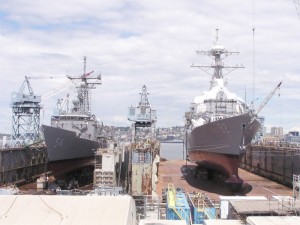In Press: Talking Shipbuilding with the Seattle Times
” />Seattle Times columnist Jon Talton got in touch last week to discuss shipbuilding, competition from Asia, and shipyard consolidation. The resulting piece, on the merger of Seattle’s Todd Pacific Shipyards with privately-owned Portland’s Vigor Industrial, came out today. It’s an interesting article, which you can read here.
First, I think the Todd-Vigor merger is pretty interesting; to me, privately-owned and operated companies are freer to take the risks required to make breakthrough plays. So Todd-Vigor, with their merger (ostensibly taking Todd private), are better positioned to make a play for contracts, make capital investments, and reap the rewards that come from being the only local naval ship repair concern in the Pacific Northwest.
Todd-Vigor is positioning itself to be a player a naval marketplace that is changing to favor smaller, adventurous shipyards–the ones that can take on experimental projects, niche craft (can you say ice-hardened or polar ice-breakers?) and are willing to build craft smaller than, oh, the massive DDG-1000.
As I say in the article, the changing face of our modern Navy favors small, agile and hungry shipyards:
Austal, an Australian company, has set up operations in Mobile, Ala., making the Navy’s new littoral combat ship and joint high-speed vessel. These are smaller, less complex vessels, similar to what Todd once made [ed: remember, Todd used to build FFGs]. “These are the projects that help prime the pump for innovative, tough, new shipyards,” said Craig Hooper, a San Francisco-based national-security consultant and blogger on NextNavy.com. It’s a foundation that can improve competitiveness against Asia for civilian contracts.
Hooper said the Todd-Vigor merger could help the company make more competitive bids, especially if it maintains high technology and efficiency standards. In addition, “Vigor is now well-positioned to take advantage of America’s ongoing transfer of existing — and aging — naval ships to the Pacific. Those ships will need to be maintained and tended, and in the Pacific Northwest,
this new entity is the only thing going. And that’s got to be something that pleases even the toughest businessman and the least sentimental investor among us.”
So I think the merger is a win-win. They’re firming up their shipbuilding resources, setting the stage for capital improvements–and positioning themselves to firm up their revenue stream. Yeah, the Navy is going to be forced to fork over some more money to get their growing set of Northwest-based Cold-War era ships maintained, but…the
Navy was going to do that anyway. The merger closes off an avenue to try some sort of local scheme to drive down costs via competitive bidding, but now, well, the Navy will need to look farther down the coast for competitor bids–to say, San Francisco. (And, well, being a Bay Area local, that ain’t half bad…Don’t think it’ll inject too much extra business here, but…every bit helps!)
We went on to discuss Asian competition–the general question being, “how can our shipyards compete with the big, efficient shipbuilders in Japan, China and South Korea?” My answer is simple–we forget that those Asian shipyards grew out of stability. And without stability, seemingly efficient shipyards can get a lot less competitive really quickly. A war in South Korea would kill–simply kill–one of the world’s largest concentrations of great shipbuilders. Any sort of border conflict or–gasp–regional war (Taiwan?) would wreak havoc on the “cheap-fast-easy” shipbuilding culture of Asia. And remember–I’ve said this many, many times–with Asia teetering on the brink of a massive naval arms race…outside of the Cold War, how many naval arms races ended, er, peacefully?
As I say in the article:
The outlook could also change because of regional instability in Asia, especially on the Korean peninsula. Hooper said, “That’s when American shipyards, with their high-quality products and stable shipyards and supply-chains, begin to look viable.”
Lacking stability, customers will look elsewhere. And that–particularly given the recent efforts to make the US a better place for export-oriented manufacturing–means only good things for any U.S. shipyard that has, thusfar, managed to survive. So, even though the shipbuilding sector is going through some trying times, I think the future is bright for U.S. shipbuilders.


{ 1 comment… read it below or add one }
This is so interesting. Thanks for the article. Its nice to hear that someone is optimistic about the shipbuilders future!